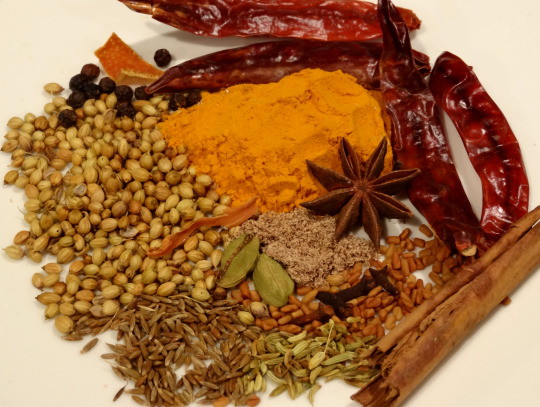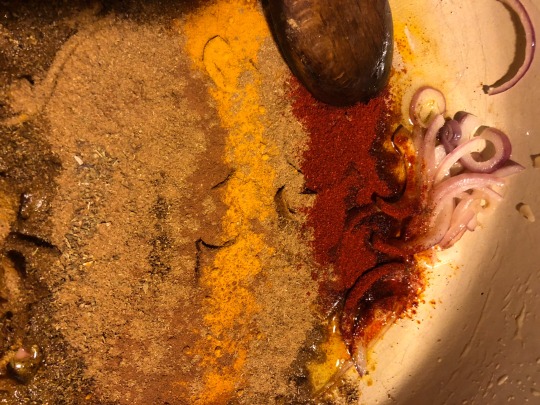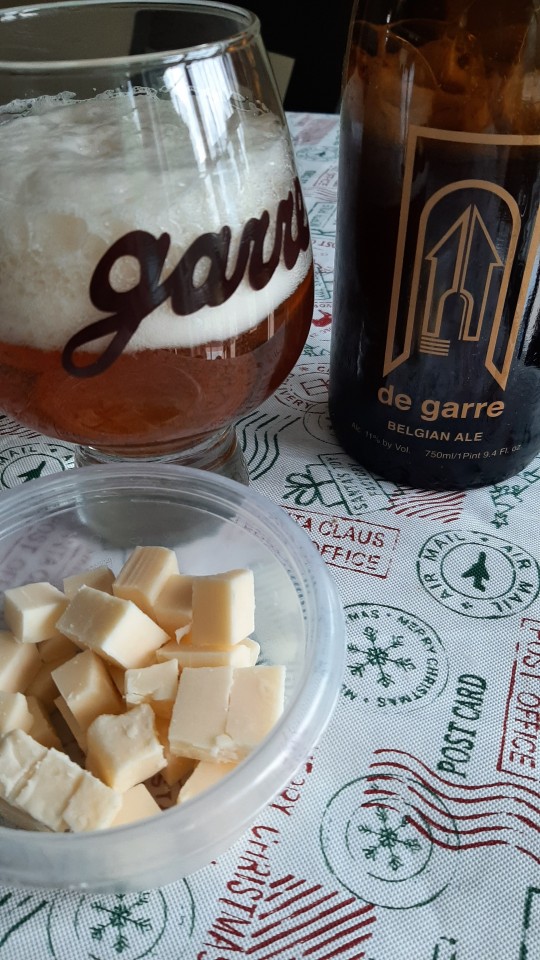#Curry Powder
Text

[ID: A plate of whole and ground spices including red chilis, Ceylon cinnamon, coriander seeds, and star anise. End ID]
新加坡咖哩粉 / Xinjiapo gali fen / Curry powder Singapura (Singapore curry powder)
Singapore curry powder, or gali fen ("gali" from the English "curry"), is a spice blend that was inspired by British Madras curry powder, but grew to incorporate Chinese spices and aromatics. It is representative of the culinary culture of Singapore, which incorporates influence from Chinese, Indian, Thai, Malay, and Indonesian cuisines.
This blend is used in “Singapore” curry fried noodles (actually a Hong Kongese dish) and in other Chinese curry dishes including chicken curry (新加坡式咖喱鸡), beef brisket curry (咖喱牛腩饭), curry soup noodles, and vegetable curries. It is also a popular choice for marinating meat and seafood.
Curry powder Singapura starts from a base of dried red chilis, and is rounded out with earthy spices including turmeric, coriander, cumin, and fenugreek. Warming spices such as nutmeg, mace, cinnamon, and cloves are often also included. Chinese influence sometimes appears in the form of chenpi (dried mandarin orange peel), Sichuan peppercorn, dried radish, liquorice root, star anise, and dried ginger.
Recipe under the cut!
Patreon | Tip jar
Makes about 1/3 cup.
Ingredients:
2 Tbsp (17.4g) ground turmeric / 薑黃
10 dry red chilis (11g; adjust to taste)
2 Tbsp (8g) coriander seeds / 芫茜
1 tsp (3.6g) fenugreek seeds (optional)
1 tsp (2.5g) cumin seeds / 小茴香種子
1 tsp (2g) fennel seeds / 谷茴
1 tsp (2g) ground ginger (optional)
1/2 tsp (1.6g) black peppercorns
1 inch (1.5g) Ceylon cinnamon / 桂皮
1 pod (1.4g) star anise / 八角
1g liquorice root / gan cao / 甘草 (optional)
1g chenpi / 陳皮(optional)
1g cao guo / tsao ko / 草果 / Chinese black cardamom, freshly grated (optional)
4 (1g) green cardamom pods
1/2 tsp freshly grated nutmeg / 玉果 (1/4 tsp preground; .5g)
1/4 tsp (7; .4g) cloves
2 blades mace (.2g; optional)
Liquorice root, chenpi, and cao guo may be found at an east Asian or Chinese grocery store, but may need to be purchased online. Many homemade versions of this spice blend do not include these spices.
Hong Kong curries tend to be relatively mild and sweet, including a lot of turmeric and cinnamon relative to the amount of chili and pungent spices. You should adjust the heat, sweetness, and pungency of the blend to your taste.
Instructions:
1. For a less spicy curry powder, you may choose to break open the chilis and remove all or some of their seeds.
2. Roughly crush star anise, cinnamon, nutmeg, and cardamom pods in a mortar and pestle or with the flat of a knife. In a small, dry skillet, toast whole spices (coriander, fenugreek, cumin, black pepper, cinnamon, fennel, star anise, nutmeg, cardamom, Sichuan peppercorn, cloves, and mace) one at a time until each is fragrant. Set aside and allow to cool.
Spices are toasted one at a time so that smaller spices don't burn before larger ones are fully fragrant. Sometimes, I'll toast larger spices (such as cloves and cardamom pods) together, and then toast smaller seeds (such as cumin) together, to speed up the process.
3. Remove pan from heat. Toast ground spices (turmeric, and anything else you used a ground version of) for 30 seconds, stirring constantly, and remove from the skillet.
4. Grind liquorice root in a spice mill or coffee grinder until as fine as possible, then pass it through a sieve to remove larger pieces. Return those pieces to the mill and grind again. This is done separately because liquorice root can be tough to grind!
5. Grind all spices in a spice mill until fine. Pass through a sieve. Store in an airtight container in a cool, dry place.
72 notes
·
View notes
Text

June 7 | Curry night strata
#curry powder#corriander#cumin#garam masala#cinnamon#oregano#tumeric#chili powder#chicken tikka masala#a la argyle#home cooking#my snapshots
9 notes
·
View notes
Text



[-Curry powder. -Wait, wait, wait, wait. Tomorrow is another day toward death. [ Laughter ] Put the flour mixture.]
#s30e01 'round the world roundup#guy fieri#guyfieri#diners drive-ins and dives#curry powder#flour mixture#tomorrow#day#death#laughter
9 notes
·
View notes
Text

Vegan Paleo Broccoli Cashew Salad (via Food Faith Fitness)
#dairy free#gluten free#gf food#gluten free foods#vegan#vegetarian#grain free#egg free#broccoli#cashews#curry powder#foodfaithfitness
8 notes
·
View notes
Photo

Recipe for Curry Udon
Udon noodles are added to a thick vegetable broth flavored with curry powder and soy sauce in this quick and easy Japanese-inspired soup.
3 notes
·
View notes
Text



When my son was visiting he decided we needed to smoke a brisket, something called armadillo eggs, and a macaroni. As my SIL's pellet smoker was here in temporary residence, why not?
All these things came out fantastically well but to my surprise the macaroni was the thing I was most impressed by. He created an incredible cheese sauce from...well too many cheeses and other things to mention but we ended up with a full pound of this Cabot "Seriously Sharp" cheese left over.
We've been trying eat up these leftovers for two weeks but tbh this cheddar is so bold, it doesn't play well with other flavors. Then I was reminded of the cheese cubes served at De Garre in Bruges. This cheese is a bit creamier than I remember that one but it still beautifully stands up to the rich, fruity, 10%'er that I so adore. I've so few bottles left!
About a week after my son returned to Europe, we received a package from Amazon. As this is a near daily occurrence, I didn't event wonder what it might be. When D said Wtf is this and it's addressed only to Shane, I took notice.
It was a 3 pack of curry sauce mix. I'd no clue! To be clear, I'd learned to like curry by eating it in English pubs back in the 90s which, I've since learned, isn't representative of curry as it's more widely know. So.
I was confounded but had more pressing issues so I put the package in a snack cart by the counter and forgot about it. A few days ago we found out it was sent to us by our friend Gary, a man from Yorkshire. We know him because he lives with one of our daughter's childhood friends. He and I had touched on the subject of food in England while we were out pub crawling in Louisville with my son. He sent it to me.
So, for lunch yesterday I decided to try out this magic powder with some fries and frankfurters. So good!
Today D and I were coming back from an early appointment and breakfast in Louisville when she expressed her surprise we were so compatible. We've been married 40 years without either resorting to shackles, blackmail, or witchcraft....as far as I know.
She went on to say if she could survive by eating a pill a day, she'd be fine with that. She didn't really care much about eating. As a self avowed foodie I can only say, I'm crazy lucky she likes me.
The creek was full of shiners! If you don't know what that is, bless your heart.
8 notes
·
View notes
Text
youtube
curry cookin'
#curry#ramen#noodle#noodles#the ramen rater#theramenrater#food#hans lienesch#soup#instant noodles#instant#arthur curry#stephen curry#tim curry#curry powder#rice#veggies#flavor#broccoli#Youtube
4 notes
·
View notes
Text
#i used to get this in the us 🥲#why don't we have it here i wonder....#recipes to try#chicken#shaoxing wine#ginger#oyster sauce#curry powder#green peppers#onions#carrot
13 notes
·
View notes
Text
The Production and Versatile Uses of Curry Leaf Plant
The curry leaf plant, also known as Murraya koenigii, is not only a staple in South Asian and Southeast Asian cuisines but also a versatile herb with numerous applications beyond the kitchen. In this article, we will explore the cultivation and production of the curry leaf plant and delve into its diverse range of uses, both culinary and non-culinary.
Cultivating the Curry Leaf Plant
Before we can dive into the various uses of the curry leaf plant, it's essential to understand how to cultivate and nurture this valuable herb.
Selecting the Right Location
Curry leaf plants thrive in warm and tropical climates, and they require plenty of sunlight. Choose a location that receives at least 4-6 hours of direct sunlight each day, whether it's in your garden or a pot on your balcony.
Soil and Potting Mix
Select well-draining soil or a potting mix that provides good aeration. Mixing regular garden soil with organic compost is an excellent choice. Ensure that your pot or container has adequate drainage holes to prevent waterlogging.
Watering and Fertilizing
Consistent and adequate watering is crucial for the curry leaf plant. Keep the soil consistently moist but not waterlogged. Fertilize your plant with a balanced, water-soluble fertilizer every two weeks during the growing season to promote healthy growth.
The Versatile Uses of the Curry Leaf Plant
Now, let's explore the wide array of applications for curry leaf beyond its culinary uses.
Culinary Delights
1. Flavorful Seasoning: Fresh curry leaves are renowned for their aromatic and distinct flavor. They are a fundamental ingredient in various South Asian and Southeast Asian dishes, adding a unique taste to curries, rice, and lentil preparations.
2. Cooking Oil Infusion: Curry leaves can be used to infuse cooking oils, creating a fragrant base for frying or sautéing ingredients. This technique imparts a delightful flavor to the oil and, subsequently, the dish.
Medicinal Properties
1. Traditional Remedies: In traditional medicine, curry leaves have been used for their potential health benefits. They are believed to aid in digestion, help manage diabetes, and possess anti-inflammatory and antioxidant properties.
2. Hair Care: Curry leaves are also valued for their role in promoting hair health. They are used in various hair care products to address issues such as dandruff, hair loss, and premature graying.
Aromatherapy
1. Aromatic Oils: The essential oil extracted from curry leaves is used in aromatherapy to reduce stress, anxiety, and promote relaxation. It can be diffused or used in massage oils.
Ornamental and Landscaping
Curry leaf plants can serve as attractive ornamental additions to your garden or landscaping. Their vibrant green foliage and fragrant leaves make them an aesthetically pleasing choice.
Conclusion
The curry leaf plant, with its rich history in culinary traditions and versatile applications, has earned a well-deserved place of honor in kitchens and gardens around the world. Its aromatic leaves and potential health benefits continue to make it a valuable addition to various aspects of our lives.
Whether you're using curry leaves to add a burst of flavor to your favorite dish, harnessing their health properties, or simply enjoying their beauty in your garden, the curry leaf plant proves to be a truly versatile and indispensable herb. Embrace the many dimensions of this herb to enhance your culinary experiences and well-being.
FAQs
Can I grow curry leaf plants in a pot or container?
Yes, curry leaf plants can thrive in pots or containers as long as they receive adequate sunlight and have well-draining soil.
What are the potential health benefits of consuming curry leaves?
Curry leaves are believed to aid digestion, have anti-inflammatory and antioxidant properties, and may help manage diabetes.
How can I use curry leaves for hair care?
Curry leaves can be used in hair masks, oils, or shampoos to promote hair growth, reduce dandruff, and prevent premature graying.
Are curry leaf plants easy to maintain?
With proper care, curry leaf plants can be relatively easy to maintain. They require sunlight, well-draining soil, and regular watering and fertilizing.
Can I use dried curry leaves in cooking?
While fresh curry leaves are preferred for their flavor, dried curry leaves can be used in a pinch. However, they may not provide the same intensity of aroma and taste.
#curry leaf#curry leaf plant#curry leaves#curry tree#curry tree fertilizer#curry plant#curry oil#curry paste#curry recipe#curry#curry powder#curry tree leaves#curry plant benefits#curry leaf benefits#Curry leaf uses
2 notes
·
View notes
Text
someone on insta made chai with curry powder
4 notes
·
View notes
Text

[ID: A bowl full of whole and ground spices in various shades of red, orange, and green. End ID]
カレー粉 / Kare ko (Japanese curry powder)
Kare ko is a spice blend that spread to Japan in the late Meiji era as a result of British imperialism. The blend (like curry powder in general) originates from a British approximation of a range of South Asian spice profiles. Domestic manufacture and sale of kare ko began in 1905 with Hachi; S&B, who began production in 1923, currently hold the major market share.
Kare ko is adapted to Japanese tastes, and is usually not very spicy. It is dominated by coriander, turmeric, and cumin, but also contains spices such as fenugreek, cardamom, clove, and star anise, as well as dried herbs including sage and dill. Popular comfort dish kare raisu ("curry rice," a pairing of rice and a curried stew featuring carrots and potatoes), uses kare ko as its primary source of flavor; kare ko is also used to make curry ramen and curry udon.
The benefit of making this spice blend at home is in its freshness and its customizability—play around with the proportions of different spices until you get something you like!
Recipe under the cut.
Patreon | Tip jar
Ingredients:
1 Tbsp (3.5g) coriander seeds
1 tsp (2.6g) turmeric
1 tsp (2.5g) cumin seeds
5-6 pods (1/2 tsp; 1g) green cardamom
1 tsp freshly ground nutmeg, or 1/2 tsp pre-ground (.6g)
1/2 tsp (2g) fenugreek seeds
1/2 tsp (.7g) ground ginger
1/2 tsp (1.3g) ground garlic
1/2 tsp (1.5g) yellow mustard seeds
1/2 tsp (1g) fennel seeds
1 cm piece (1/4 tsp; .7g) cassia cinnamon
1/2 tsp (1.3g) black pepper
1/2 tsp (1.2g) paprika
1/2 tsp (1.2g) cayenne pepper (optional)
4-5 (1/4 tsp; .5g) whole cloves
2-3 (1/4 tsp; .5g) allspice berries
2 Mediterranean bay leaves (laurel)
1 star anise pod (2g)
1 tsp chen pi (dried tangerine or mandarin orange peel) (1.2g)
1/4 tsp (.2g) dried thyme
1/4 tsp (.2g) dried sage
1/4 tsp (.2g) dried dill
Pinch MSG (optional)
Pinch asafoetida (hing; optional)
Chen pi is commonly used in Chinese and Japanese cooking and can be purchased at an East Asian grocery store.
Though Japanese curry powder is ultimately drawing from South Asian cuisine, recipes for it tend to call for Mediterranean bay leaves rather than Indian bay leaves (tej patta; really a type of cinnamon leaf).
Instructions:
1. In a dry skillet on medium, toast large whole spices (cinnamon, star anise, green cardamom, cloves, allspice) for a few minutes until fragrant and set aside. Repeat with smaller seeds (coriander, cumin, fenugreek, mustard, and fennel) and bay leaf. Set aside and allow to cool.
2. Remove skillet from heat. Toast ground spices and dried herbs, stirring constantly, for about 30 seconds until fragrant. Remove from skillet.
3. Grind all spices and herbs in a spice mill or mortar and pestle and strain through a fine mesh sieve. Store in an airtight container in a cool, dry place.
57 notes
·
View notes
Photo

Eating homemade coronation chicken while watching the actual coronation of King Charles III is a whole mood.
Here’s the classic Coronation Chicken sandwich filling recipe if you’d like to make it yourself! My Mom’s recipe uses celery, fresh black grapes, green onions, dried apricots, and chopped cashews in addition to the basic ingredients shown here.
Fortnum & Mason and Tom Parker Bowles’s Coronation chicken sandwiches
This version omits the original nuts and uses fresh coriander, plus plump raisins, mango chutney and a little spice to keep all that naughty sweetness in check.
Ingredients
Makes 16 finger sandwiches
1tbspn vegetable oil
1½tbspns mild curry powder
1tspn turmeric
3 cooked chicken breasts, skinned and finely diced
8–9tbspns good-quality mayonnaise
3tbspns mango chutney
1tbspn chopped golden raisins
2tbspns chopped coriander
Salt and freshly ground black pepper
Butter, for spreading
8 large slices of white bread
Method: Gently heat the vegetable oil in a small pan, add the curry powder and turmeric and cook over a very low heat for one minute, stirring constantly. Remove from the heat and cool slightly. Put the diced chicken into a bowl, add the spice mixture and rub it into the chicken. Add the mayonnaise, mango chutney and raisins and mix well. Fold in the chopped coriander and season to taste.Lightly butter the bread and spread the Coronation chicken mixture over half the slices. Sandwich together with the remaining bread, cut the crusts off, then cut each sandwich into four fingers.
From ‘The Cook Book: Fortnum & Mason’ by Tom Parker Bowles (Fourth Estate, £30). Tom’s new book with Fortnum & Mason, ‘Time For Tea’, is out now (Fourth Estate, £20)
#coronation#coronation of king charles iii#king charles iii#coronation day#coronation chicken#curry powder#anglo indian food#british indian food#chicken salad#chicken recipes#british food#british cuisine#sandwich#mayonnaise#mango chutney#sandwich filling
2 notes
·
View notes
Text
Curry Udon with a Crispy Tofu Katsu
Chef’s Note: I have fallen in love with this curry. And the tofu was so crispy!
Original recipe’s link
Ingredients
Curry
8 oz udon noodles
1 medium yellow onion, sliced
1 carrot, sliced
1 red bell pepper, sliced
2 garlic clove, minced
1 thumb-size piece of ginger, minced
3 tbsp unsalted butter
4 tbsp all-purpose flour
1 1/2 tbsp curry powder
4 cup vegetable broth
1 tbsp low-sodium soy sauce
1 tbsp ketchup
1 tbsp maple syrup
salt, to taste
Tofu Katsu
8 oz firm tofu
4 tbsp cornstarch
salt
paprika
5 tbsp milk
1/2 cup bread crumbs
vegetable oil
Instructions
Curry
0. If your udon isn’t pre-cooked, cook the noodles according to package directions
1. Slice the onion, carrot, and bell pepper. Mince the garlic and ginger
2. Melt butter over medium-high heat. Fry the vegetables, garlic, and ginger until soft/tender
3. Stir in flour and curry powder. Stir until the vegetables are coated.
4. Add in the vegetable broth, soy sauce, ketchup, and syrup. Season with salt and adjust seasoning as necessary. Lower heat and simmer until thickened.
5. Stir the udon noodles into the sauce.
Tofu Katsu:
1. Cut the tofu into filets
2. In a shallow dish, pour the cornstarch. Season with salt and paprika
3. In a second shallow dish, pour the plant milk
4. In a third shallow dish, pour the breadcrumbs
5. Dip the tofu filet into the cornstarch, milk, then breadcrumbs.
6. Fry the breaded filets in oil until crispy
#japanese#stovetop#frying#udon noodles#yellow onion#carrot#red bell pepper#garlic clove#ginger#butter#unsalted butter#flour#all purpose flour#curry powder#vegetable broth#soy sauce#ketchup#maple syrup#salt#firm tofu#cornstarch#paprika#milk#bread crumbs#vegetable oil
2 notes
·
View notes
Text

Tonight, I worked up enough of a combination of slightly morbid curiosity and courage to try one Swedish classic!
This place's version of an "Afrikana" involves shrimp, along with the peanuts. Shrimp is another topping which shows up more than I ever would have expected to see on menus, but more places do seem to use ham on an Afrikana if it's not just vegetarian .
Swedish pizza really is its own special art form. Seriously, the common variety and combinations of toppings continues to astound. And I am mostly down for the challenge.
Still not entirely sure about the concept of non-dessert banana pizzas, however. 😅

I decided to go Full Swedish with it, and pull out the tub of beasås, because why not. Plus the crust edges looked a tad dry.
The verdict? Honestly better than I expected. It's fairly thin slices of fruit, and the dusting of curry powder does help turn the them away from full cloying mode.
Not sure this is on my shortlist of combinations to order again. Probably another of those acquired tastes. But, it's not actively unpleasant, and I'm glad to try it.
3 notes
·
View notes
Text
Hello Fresh: Curried Chickpea Fritters
The Recipe (Serves 4)
Ingredients:
- 2 13.4oz cartons of chickpeas
- 164g tempura batter mix
- 1 red onion
- 1 Tbs curry powder
- 2 bunches scallions
- 1 c Basmati rice
- 4 Tbs yogurt
- 6 Tbs sour cream
- 1 lemon
- 2 cloves garlic
- 2 oz golden raisins
- 5 oz spinach
- 1 oz cashews
- 2 packets veggie stock concentrate
- frying oil
- 2 Tbs butter
Prep vegetables: Wash and dry produce. Halve, peel, and finely dice onion until you have 1 cup. Mince remaining onion until you have 4 Tbs and set aside.
Trim and thinly slice scallions, separating whites from greens.
Roughly chop spinach.
Quarter lemon.
Peel and mince garlic.
Drain and rinse chickpeas.
Cook rice pilaf: Melt 2 Tbs butter in a small pot over medium-high heat. Add diced onion, scallion whites, cashews, and a pinch of salt. Cook ~1 minute. Stir in rice, stock concentrate, 1 1/2 c water, and a big pinch of salt. Bring to a boil, then cover and reduce heat to low. Cook until rice is tender (~15-18min). Turn off heat. Add spinach. Cover until wilted (~2min), stir to combine.
Soak raisins and mix sauce: Place raisins in a small bowl. Add juice from half a lemon, a pinch of salt, and just enough hot water to cover. Set aside to pickle.
In a separate small bowl, combine sour cream, yogurt, a squeeze of lemon juice, and a pinch of garlic. Add water 1 tsp at a time until mixture reaches a drizzling consistency. Season with salt and pepper.
Make batter: Add chickpeas to bowl with minced onion. Mash with potato masher or fork until almost smooth.
Stir in tempura batter mix, scallion greens, remaining garlic, 2/3 c water, 1 Tbs curry powder, salt, and pepper.
Cook fritters: Heat a 1/3″ layer of oil in a large heavy-bottomed pan over medium-high heat (we used our cast iron pan). Once oil is hot enough that a drop of batter sizzles when added, add 1/4-cup scoops of batter. Cook until golden brown and crisp (~3-4min per side).
Using a slotted spoon, transfer fritters to a paper-towel-lined plate. Season with a pinch of salt.
Serve: Divide rice pialf between plates and top with chickpea fritters. Drizle with creamy garlic sauce and pickled raisins (draining first).
Thoughts on this recipe~
They reminded me of potato croquettes, but obviously chickpea. M said this one was a winner. I just wish it had fewer specialty ingredients. XD We might have to add a few things to our stock of pantry staples.
#chickpeas#tempura batter mix#red onion#curry powder#hello fresh#vegetarian#basmati rice#rice#sour cream#yogurt#golden raisins#spinach#cashews
4 notes
·
View notes
Photo

Curry Chicken Salad
#A straightforward cold chicken salad is elevated by a tiny bit of curry powder. bread#chicken salad#curry powder#salad#curry chicken salad recipe#lettuce
2 notes
·
View notes